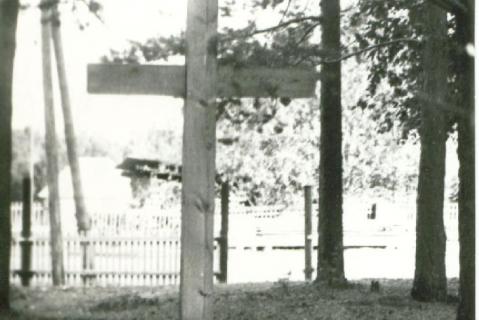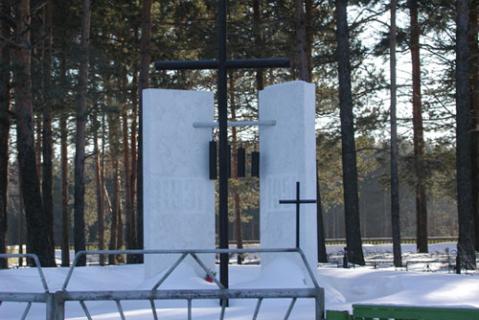A special settlement called Mogilny Yar was set up for dekulakized peasant families in 1933. After 1939 it was known as the Novy Vasyugan village. In the 1940s deportees from the Baltic States and the Caucasus were brought there. The men, women and children who died were buried in common and individual graves in a separate graveyard on the banks of the Vasyugan river. Subsequently most of the area was used for building and allotments and only a small section covered in young pine trees remained.
In 1989 Yu. Lehtrandt and K. Tuulik came there from Estonia. Former inmates of the Togursky and Aipolovsky children’s homes for orphaned deportees, they erected a cross in the graveyard in memory of their dead compatriots bearing the word “Memento”. In 1996 former exiles erected a memorial to all who died in Vasyugan; the costs were covered by the Tomsk Regional and Kargasoksky district administrations. The next year Tomsk writer V.N. Maksheyev, himself a former forced settler put up a monument (designer V.N. Moroz), paid for by the district administration, “In memory of the victims of political repression, 1931-1951”. During the 2000s personal memorials were placed in the graveyard for those who died in exile: O.F. and S.N. Maksheyeva (1936-1942), M.V. Karamzina (1940-1942) and N. Paulsen.
The Memorial online database (2025) names 217,732 victims in the Tomsk Region (BR 20,603). See Mount Kashtak.
It includes 197,129 deportees from police records. 146,154 were sent to the Tomsk Region from other parts of the USSR (over 100,000 from the Altai Republic and Siberian Regions – Novosibirsk, Omsk, Krasnoyarsk and Kemerovo); many victims were subsequently born there (38,293).
125,306 were convicted in the early 1930s (most accused of being “kulaks”), no less than 106,219 in 1930-1. 23,000 were later deported there or reclassified as Germans.
Police record the deaths of 18,465 deportees, over 12,000 of whom had been sent to the Tomsk Region as “dekulakised peasants” in the early 1930s.
| Date | Nature of ceremonies | Organiser or responsible person | Participants | Frequency |
|---|---|---|---|---|
|
30 October
|
Remembrance Day for the Victims of Political Repression
|
Administration of Novovasygansky rural settlement
|
Administration officials, village residents, descendants of the victims of repression
|
Annual event
|
|
Commemorative Services
|
nk
|
nk
|
From time to time
|
| State of burials | Area | Boundaries |
|---|---|---|
|
dozens of graves have survived
|
0.3 hectares
|
delineated
|
[ original texts and hyperlinks ]
V.N. Maksheyev (compiler), Narymskaya chronicle, 1930-1945. The tragedy of the forced settlers, documents and memoirs, Moscow, 1997 (255 pp)
“The Novy Vasugan rural settlement”, Official website of the Kargasoksky district [retrieved, 29 May 2022]
Yu. Zalivina, “United we cannot be defeated … A school project”, Novy Vasyugan middle school, 2013
*
Reply from Tomsk Region department for information and public relations (№ 17-293 of 13 May 2014) to a formal enquiry by RIC Memorial (St Petersburg)


